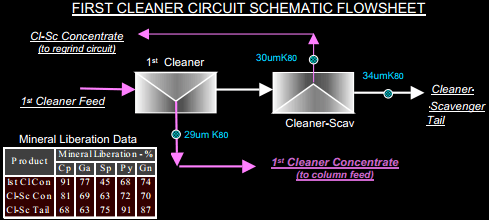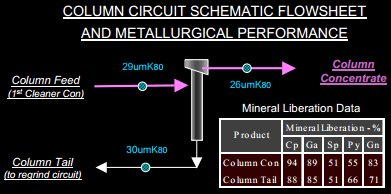To facilitate the presentation of the modal data, the cleaner circuit of this case concentrator was separated into three operations. The first cleaner circuit, which includes the cleaner-scavenger bank is discussed first, this is followed by a discussion of the operation of the column cleaner circuit. Finally, an analysis of the overall cleaner circuit operation is presented.
First Cleaner Circuit Performance: A synopsis of the metallurgical performance around the first cleaner circuit is shown below.  The behavior of the mineral species by class of association and by size range across the first cleaner bank is summarized here.
The behavior of the mineral species by class of association and by size range across the first cleaner bank is summarized here.
 It is apparent that the first cleaner is operated very selectively to recover about 60% of the chalcopyrite feeding the unit and only 20% of the galena. Most of the remaining chalcopyrite and galena bearing mineral particles are recovered into the cleaner- scavenger concentrate. This concentrate is then recycled to the regrind circuit, and reground in preparation for retreatment in the cleaner circuit.
It is apparent that the first cleaner is operated very selectively to recover about 60% of the chalcopyrite feeding the unit and only 20% of the galena. Most of the remaining chalcopyrite and galena bearing mineral particles are recovered into the cleaner- scavenger concentrate. This concentrate is then recycled to the regrind circuit, and reground in preparation for retreatment in the cleaner circuit.
Column Circuit Performance:
A summary of the metallurgical performance of the flotation column circuit at the time of the case survey is presented here below.  The flowsheet and performance of the minerals by particle size range and by class of association are summarized here.
The flowsheet and performance of the minerals by particle size range and by class of association are summarized here.


The column circuit recovers just 42% of the chalcopyrite feeding the circuit. Lead and zinc bearing minerals are both about 20% recovered into the concentrate. Liberated grains of chalcopyrite were about 40% captured. Chalcopyrite sized finer than 10µm were 50% recovered while about 30% of grains sized coarser than 40µm were captured. These recovery by size profiles are atypically low. Usually, column cells recover liberated copper sulphide particles efficiently over a relatively narrow band in the mid size range. These unusual recovery profiles may be due to excessive recirculation loads feeding the cleaner circuit.
Overall Cleaner Circuit Performance:
The recoveries by mineral species by size range and class of association across the overall cleaner circuit are here displayed graphically.

 The metallurgical performance of the cleaner circuit is summarized below.
The metallurgical performance of the cleaner circuit is summarized below.
About 85% of the chalcopyrite in the cleaner block feed was eventually recovered into the final concentrate. A review of the recovery by size profiles indicated that liberated chalcopyrite, and chalcopyrite-galena binaries, sized coarser than 15µm in diameter, were efficiently recovered into the final concentrate. For particles of these classes sized finer than 15µm, a significant reduction in flotation recovery was observed.
It is interesting to note that liberated galena was poorly recovered in the copper cleaner circuit, particularly for particles sized coarser than 20µm. This data demonstrates a distinct differential between chalcopyrite and galena flotation rates. Therefore, recovering galena into a selective lead product should be considered possible and investigated via further flotation testwork.
